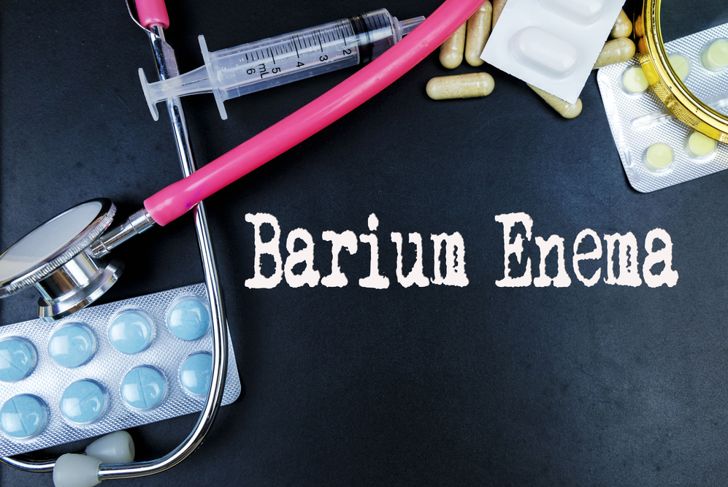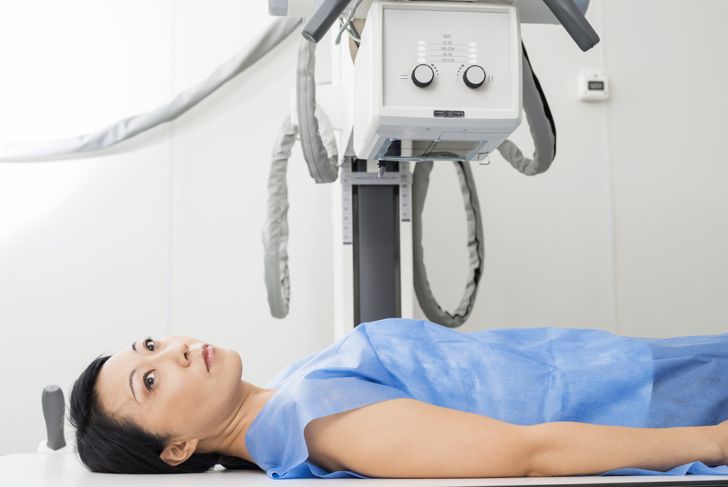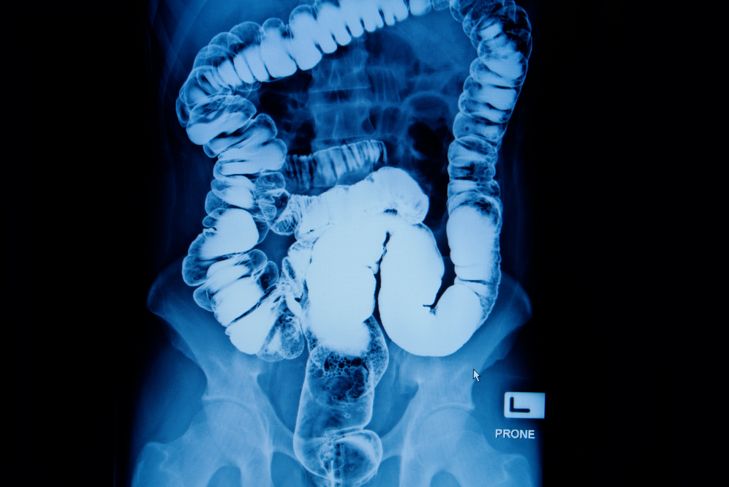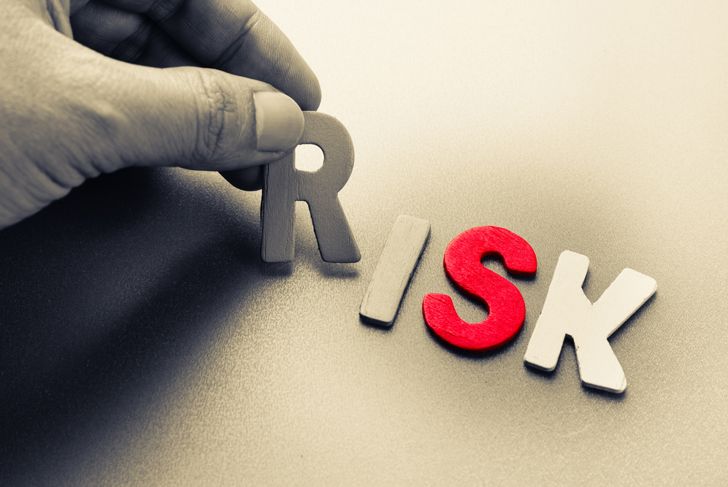A barium enema is an X-ray imaging test of the lower intestinal tract that uses a contrast solution containing the metallic element barium. The barium solution is delivered through the use of an enema, a process in which liquid is pushed into your rectum through your anus while a technician takes X-ray images of the area. Barium enhances the X-ray images by highlighting certain areas of tissue and allows the radiologist to see your internal organs in motion by tracking the flow of the barium solution through your intestinal tract.
Why Barium Enemas Are Done
Your doctor may order a barium enema if an abnormality in your lower gastrointestinal (GI) tract is suspected. There are various symptoms and health conditions which could prompt your doctor to examine your lower GI tract, including:
- Abdominal pain
- Blood in your stools
- A change in your bowel movements
- Crohn’s disease
- Chronic diarrhea
- Colorectal cancer
- Diverticulitis
- Irritable bowel syndrome
- Polyps
- Rectal bleeding
- Twisted loop of the bowels (volvulus)
- Ulcerative colitis
Preparation For a Barium Enema
Before the day of the barium enema test, limit your diet to clear liquids. Your doctor will ask you to empty your bowels through the use of cleansing enemas and laxatives. This is called a bowel prep. To avoid any complications or cancellation of the procedure, you need to abstain from eating anything after midnight the night before the procedure. Many doctors recommend limiting your diet to clear liquids the entire day before the test. On the day of the procedure, you can drink clear liquids, such as water, tea, juice, or broth. This is to ensure that your colon is clear of any stool, which could show up in the X-ray images. Be sure to let your doctor know of any bowel movement problems or irregularities before the test.
Who Performs the Test
Normally, two people will be performing the test: a radiologist and a radiology technologist. They work together and stay with you the entire test. A barium enema involves filling the colon and rectum with a white liquid material (barium) through a catheter (tube) inserted into the rectum through the anus. An X-ray machine is placed in front of you with X-ray film placed behind. The radiologist will also use a fluoroscope, an X-ray device on which the barium can be seen in motion flowing into the colon.
What to Expect When You Check In For Your Test
A barium enema usually takes between 30 and 60 minutes and is performed at a hospital or specialized testing facility. You’ll change into a hospital gown and remove any jewelry or other metal from your body. Metal can interfere with the X-ray process. You’ll be on an exam table. X-rays will be taken to ensure that your bowels are clear. A physical rectal exam may also take place.
What to Expect During the Test
The radiologist will insert a small lubricated tube into your rectum and slowly injects the barium and water mixture. The radiologist may also push air into your colon after the barium has been delivered to allow for even more detailed X-ray images. This is called an air-contrast barium enema. The technician will instruct you to hold still and hold your breath while the X-ray images are taken. This might be uncomfortable, but it’s not painful. You’ll be repositioned several times to take pictures of your colon from different angles. This may cause mild discomfort and cramping. Be sure to alert the technician if you’re having trouble keeping the solution in your colon. It is normal during the procedure to feel fullness or mild discomfort in the abdomen.
What to Expect After the Procedure
After the procedure, much of the barium and water will leave through a tube. However, your bowel movements may be lighter in color until all the barium is gone. Barium may cause constipation or possible impaction after the procedure if it doesn’t leave your body. To avoid this drink plenty of fluids and eat foods high in fiber. You may also be given a cathartic or laxative to help expel the barium. The rigorous bowel preparation before the procedure may cause fatigue afterward. You should rest as needed. You may experience soreness of the anus and rectum due to the bowel preparation. Your doctor may recommend applying a soothing ointment to the area.
Results
The radiologist prepares a report based on the results of the examination and sends it to your doctor. The results are either negative or positive.
- Negative result. A barium enema exam is negative if the radiologist detects no abnormalities in the colon.
- Positive result. A barium enema exam is positive if the radiologist detects abnormalities in the colon. Depending on the findings, you may need additional testing, such as a colonoscopy, to examine any abnormalities more thoroughly, biopsied or removed.
Your doctor will discuss your results with you and the next steps.
About the Images
We can see images of the colon by exposing the abdomen to the radiation. The contrast in density between the barium-filled colon and other structures of the abdomen are apparent on the X-ray and provide a clear outline of the colon. Additional static images of the colon can come from plain X-ray film or computerized digital image. Most of the barium will be drained leaving only the small amount sticking to the lining of the colon. Air is then introduced into the colon to expand it. Further X-rays are then taken to provide more detail of colon’s lining. This procedure is called a double contrast barium enema since both air and barium are used to provide the images. Polyps and small cancers are more readily found using this technique.
Possible Side Effects of the Barium Enema
Be sure to contact your doctor if any of these problems occur after the test:
- A difficulty with bowel movements or inability to have a bowel movement
- Pain and swelling of the abdomen
- Stools that are smaller in diameter than normal
- Fever
- Rectal bleeding
Your doctor may give you additional or alternate instructions after the procedure, depending on your particular situation.
Risks
Any test involving radiation, including X-rays, carries a slight risk of cancer. However, the benefit of an accurate diagnosis far outweighs the risks from the small amount of radiation you’ll be exposed to. Many things you regularly do, such as flying in an airplane, expose you to much more radiation than an X-ray. If you are pregnant or believe you may be pregnant, tell your doctor. X-rays are not for pregnant women because the radiation could harm your unborn child. If you have a tear in your colon, your doctor may opt for a contrast solution with iodine in it. This solution causes fewer potential complications if it leaks out of your colon. The most common risk of a barium enema is an allergic reaction to the barium solution. Tell your doctor about any allergies you have.

 Home
Home Health
Health Diet & Nutrition
Diet & Nutrition Living Well
Living Well More
More




















